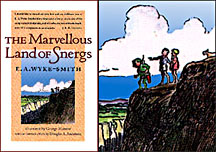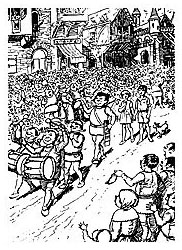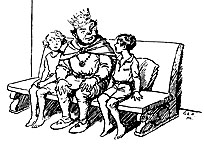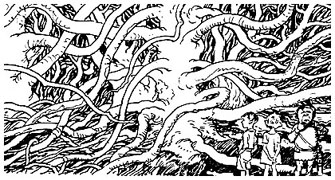 Snergs as Hobbits Snergs as Hobbits
A Review of The Marvelous
Land of Snergs
Authored by Edward A.
Wyke-Smith (1871-1935) with illustrations by George Morrow. A new
facsimile edition containing an Introduction by Douglas A. Anderson,
published by Old Earth Books, P.O. Box 19951, Baltimore MD 21211.
Cover Design by Glen Burris.
Click here to purchase: Marvellous Land of Snergs
Reviewed by J.
Michael Williams
As the father of two
small children, I am frequently in the situation of reading childrens
books aloud. My average is about two books per day. As such, I feel
in a uniquely qualified position to review The Marvelous Land of
Snergs (Snergs). This review will cover Anderson's introduction,
the unique nature of Snergs as a childrens story and its influence
on J. R. R. Tolkien's work.
Douglas Anderson, author
of The Annotated Hobbit, has written an introduction, a short biography
of Wyke-Smith and a bibliography that rivals Snergs itself for entertainment.
Part of this is surely due to the interesting experiences of Wyke-Smith
himself, who lived a life of adventure in exotic places.
As a young man, Wyke-Smith
asserted his independence by rejecting his fathers plans for him
to become an artist and he joined the Horse Guards at Whitehall.
This appears contrary to the approach of more recent generations
in which young men avoided the military to become artists! As it
turned out, Wyke-Smiths father bought him out of military service
for a considerable sum. Following this, Wyke-Smith promptly joined
the crew of a great windjammer and sailed to Australia and the west
coast of the United States. In the American West, he worked as a
cowboy. After returning to England, Wyke-Smith studied mine engineering
and managed mines in Mexico, the Sinai, South America, Spain, Portugal
and Norway. In Mexico, he accomplished the harrowing rescue of his
wife from the capital during the revolution of 1913 and during World
War I, he built a pontoon bridge across the Suez canal.
While on a trip abroad,
Wyke-Smith wrote a fairy tale at the request of one of his children.
This later became his first book, Bill of Bustingforths. This book
was published concurrently with another childrens book, The Last
of the Barons, by Oxford University Press in 1921. Some Pirates
and Marmaduke (1921), Captain Quality (1922), The Second Chance
(1923), Because of Josephine (1929) and Fortune My Foe (1925), all
novels for adults, appeared soon thereafter. The Marvelous Land
of Snergs was published in 1927. This was Wyke-Smith's last
published work. He died in Cornwall in 1935.
Douglas Anderson' s description
of these events in the form of an Introduction is excellent given
he was probably working under space limitations. This is unfortunate
since many of Wyke-Smith' s adventures deserve a chapter of their
own. It would also have been interesting to hear more about the
writing of Snergs. Now that Tolkien readers have been spoiled by
Christopher Tolkien' s detailed analysis of the construction of
The Lord of the Rings, reported in the History of Middle-Earth series,
I expected a similar analysis of Snergs. I am not sure what information
Anderson had concerning the construction of Snergs but more analysis
would have been helpful in presenting a context for this particular
fairy story. This is compelling since Snergs stands out as "
pure " Tolkienesque subcreation. There is no transition from
the real to the fairy world. The land of the Snergs is a place somewhere
on Earth, just a little out of reach of our current navigational
skills.
Snergs begins with an
explanation of Mrs. Watkyns and the Society for the Removal of Superfluous
Children (SRSC). Mrs. Watkyns and a number of other matronly women
formed a union to rescue neglected or abused children and by some
unexplained method invented by the remarkable Mrs. Watkyns, transport
them to the relative safety of the Land of Snergs. Here they are
cared for in a commune of sorts at Watkyns bay, watched over by
the matronly women. The settlement was constructed by Snergs, a
robust and helpful race of short people (" only slightly taller
than the average table" ), who provide a number of services
to the settlement. The vicinity of Watkyn' s bay also includes the
camp of Captain Vanderdecker and the crew of the Lost Dutchman,
who have settled into a retirement life that includes occasional
hunting expeditions with the Snergs. The town of the Snergs is nearby
but not so close that visits are commonplace. Surrounding these
areas is a pleasant forest inhabited by friendly cinnamon bears.
The area beyond the town of the Snergs is bounded by a deep ravine
with an impassible, swift-running river in the bottom. The lands
beyond the river are largely a mystery but prominently include Sir
Percival, a traveling knight, Golithos, an ogre who is trying to
mend his ways, and a wicked witch named Mother Meldrum.
The adventure begins
when two children, Sylvia and Joe, decide to slip away secretly
and have an adventure by visiting the town of the Snergs. They have
a general sense of the direction but get lost in the surrounding
forest. There they meet a stalwart Snerg, Gorbo, who guides them
to the town of the Snergs, and indeed, throughout the entire adventure.
 Gorbo is presented as
a type of social outcast because he is bumbling and generally dim-witted.
The social standing of a Snerg is evident by his proximity to the
King of the Snergs during feasts. It suffices to say that it is
impossible to see the King from Gorbo' s seat at the banquet table. Gorbo is presented as
a type of social outcast because he is bumbling and generally dim-witted.
The social standing of a Snerg is evident by his proximity to the
King of the Snergs during feasts. It suffices to say that it is
impossible to see the King from Gorbo' s seat at the banquet table.
Gorbo leads the children
to the town of the Snergs and all seems well. However, the next
day, during a short tour of the area around the town, Gorbo gets
the children and himself lost in the nearby Forest of Twisted Trees.
After making their way through some fantastic caverns, they emerge
on the other side of the great river, far from home, with no practical
way of getting back across the river. Then follows a series of contacts
with the characters across the river.
In the meantime, Captain
Vanderdecken and the King of the Snergs launch a campaign to rescue
the children and Gorbo. The crafty Vanderdecken devises a method
to propel a ship' s anchor and line across the river chasm. This
enables them to cross the river and search for the children.
Gorbo and the children
have some dangerous adventures engineered by the evil Mother Meldrum.
Gorbo makes a few mistakes but demonstrates his devotion and bravery.
The children are saved by Gorbo' s adept archery and the accomplished
marksmanship of Vanderdecken' s men. In the end, Gorbo takes his
place as hero only seven seats from the king at the next banquet.
The Marvelous Land of
Snergs has elements in common with Alice in Wonderland and Peter
Pan. The land itself has many features of an island, similar to
the structure of Never Land in Peter Pan. This association is also
reinforced by the presence of isolated, disparate groups, similar
to the Lost Boys vs. Mermaids vs. Pirates in Never Land. These groups
have limited communication and each is a stark contrast to the others.
Wyke-Smith contrasts the settlement of the children to the crew
of the Flying Dutchmen to the town of the Snergs, and so on.
The Alice in Wonderland
features include fantastic elements, such as a cavern of giant mushrooms
being eaten by a giant, otter-like creature, and a rambling, dream-like
quality to the plot. In this plot, the main characters experience
fantastic environments in haphazard sequence. This occurs in much
the same way that Alice meets Dweedle-Dee and Dweedle-Dum, then
the Mad Hatter, then the Cheshire Cat, and so on through the story.
These stories have a mad-cap quality because the events, although
entertaining, have no foundation structure, such as character development,
suspense or other conventional plot elements.
Wyke-Smith transcends
such superficial, dreamlike stories by creating a true fairy story,
along the lines that were later elucidated by Tolkien (1964) in
his famous essay, " On Fairy Stories" dedicated to Andrew
Lang. In this essay, a fairy story is defined by the creation of,
" ... the Perilous Realm itself, and the air that blows in
that country" . The creation of the fairy world is the major
task of the writer, and so success is measured by the degree to
which the alternative world is internally consistent and fosters
the necessary suspension of skepticism that carries the reader into
this world. Although subcreation was clearly the implicit aim of
Wyke-Smith' s efforts, Snergs does not completely represent the
fairy story as Tolkien described it. The story is hampered by a
problem Tolkien identified in his essay: tales constructed just
for children often miss the goal of complete subcreation. Whenever
the author simplifies the text, includes parenthetical asides, or
other methods designed to engage children, the subcreation suffers
tremendously, even to the point of appearing cartoon-like.
This strategy was taken
to a most pathetic extreme by Walt Disney et al. The contrast of
the original story presented by the Brothers Grimm to the Disney
version of Snow White immediately exposes the defects in subcreation
when assumptions are made about the intelligence and gullibility
of children, and then attempts are made to construct a story from
these misguided notions. Both Wyke-Smith in Snergs and Tolkien in
The Hobbit succumb to this tendency and these stories fall short
of Tolkien' s later constructed standard of subcreation.
 For Wyke-Smith, this
resulted in a story that lacks some features of internal consistency
that are obvious to adults but presumably unnoticed by children.
For example, the land of Snergs has no apparent history. The inconsistency
between the presence of medieval knights, seventeenth century Dutch
sailors and early twentieth century matrons is not easy to accept.
The SRSC has the same place in the work as the Lost Boys in Peter
Pan and its presence in the story results in the same inconsistency:
What happens to the children when they grow up? Of course, the Lost
Boys are perpetual children; the children in the SRSC presumably
grow up but their place in the Land of Snergs as adults is not explained.
These inconsistencies detract from the subcreation. For Wyke-Smith, this
resulted in a story that lacks some features of internal consistency
that are obvious to adults but presumably unnoticed by children.
For example, the land of Snergs has no apparent history. The inconsistency
between the presence of medieval knights, seventeenth century Dutch
sailors and early twentieth century matrons is not easy to accept.
The SRSC has the same place in the work as the Lost Boys in Peter
Pan and its presence in the story results in the same inconsistency:
What happens to the children when they grow up? Of course, the Lost
Boys are perpetual children; the children in the SRSC presumably
grow up but their place in the Land of Snergs as adults is not explained.
These inconsistencies detract from the subcreation.
The other annoying result
of a writing style tailored for children is that the author develops
a tendency to speak directly to the reader. Wyke-Smith does this
prominently by telling the reader the moral of the story and the
character changes associated with Gorbo. Tolkien does this in The
Hobbit with parenthetical material in the text. The authors almost
become characters in the story as their narrative intrusions become
overbearing. These features of the writing style are derived from
the author' s expectation that children require a narrative lesson.
They detract from subcreation because they emphasize the contrast
between the fictional nature of the story and the real world of
the author and reader. Although Tolkien began The Lord of the Rings
in this same style, by the time the Hobbits reached Bree, he apparently
came to a clear understanding of this problem in recent fairy tales
and was able to formulated a formal theory of this literary genre
(Carpenter, 1977). Wyke-Smith did not have the benefit of Tolkien'
s analysis and so wrote a conventional modern, childrens story,
that was a blend of subcreation with the infantilizing elements
that characterize " childrens" literature.
What were the aspects
of Snergs that may have inspired J. R. R. Tolkien? Tolkien did not
write at length about Snergs and only made a few notes about it
for his Andrew Lang lecture, " On Fairy Stories" . He
referred to it as an unconscious source reference for the Hobbits,
and nothing more. He did not like the medieval elements but noted
the great enthusiasm for the story among his own children. In the
introduction to Snergs, Anderson essentially agrees with Tolkien
that the only influence on The Hobbit was the community of the Snergs.
They are similar to Hobbits in physical features and general culture.
Anderson also cites the similarities in writing style common to
the two books.
I believe there were
two other influences derived from the Snergs that appear in Tolkien'
s work. The first of these is the unique example of subcreation
constructed by Wyke-Smith. After consideration of the inconsistencies,
Snergs is one of the few fairy stories written in the modern period
that approaches Tolkien' s expectation for genuine subcreation.
The stories he cites in " On Fairy Stories" as models
of subcreation are " traditional" in the sense that they
were stories written long before the modern era of childish fairy
tales. I believe this represents an unconscious or implicit influence
on Tolkien' s later creation. Although Wyke-Smith does not develop
this sufficiently, the Snergs represent an entire society of people
who have a history and culture. The detailed history and culture
of Hobbits described in The Lord of the Rings may be considered
an elaboration of the brief sketch of the Snergs given by Wyke-Smith.
" I should like
to record my own love and my children's love of E. A. Wyke-Smith's
Marvellous Land of Snergs, at any to the snerg-element in that tale,
and of Gorbo, the gem of dunderheads, jewel of a companion in an
escapade. " -- J. R. R. Tolkien
The physical properties
of the Land of Snergs is similar to Middle-earth in all its basic
aspects. Middle-earth is presented as our own Earth at an earlier
time when it was shaped differently but still maintained the same
natural laws that govern Earth now. The Land of Snergs is actually
a place on Earth that is set apart somewhere and only approached
through the great navigational skills of Captain Vanderdecken or
Mrs. Watkyns. This similarity is crucial for believable subcreation
and stands in contrast to the inconsistent other worlds created
in such works as Peter Pan and Alice in Wonderland.
It is possible that when
Tolkien saw the excitement for Snergs in the reaction of his own
children, this prompted him to develop similar narrative childrens
stories derived from the informal tales he had constructed for his
children in the past. The result was The Hobbit, a narrative tale
of adventure for children that included a few obscured mythological
elements from The Silmarillion. This process continued in the early
phase of The Hobbit sequel, called, " The New Hobbit"
. Once the childrens elements were exorcised, " The New Hobbit" became The Lord of the Rings, a complete narrative, epic romance
derived from the mythology of The Silmarillion.
The second influence
derived from Snergs was the character of Gorbo. I believe the character
Trotter in early drafts of The Lord of the Rings was implicitly
modeled after Gorbo in Snergs. Trotter was a worldly, well-traveled
Hobbit who Tolkien imagined would be Frodo' s guide and helper after
he left the Shire. This character later became Aragorn. The role
played by Aragorn from Bree to Rivendell is essentially the same
one taken by Gorbo in Snergs. Aragorn takes the role of knowledgeable
guide and, like the children in Snergs, the four Hobbits are completely
dependent upon him. Of course, there are differences between the
characters. In particular, Aragorn' s character is revealed by events
and Gorbo' s is developed by them, in the same way that Bilbo' s
character is developed in The Hobbit. Regardless, this role of guide
and defender adopted by Trotter/Aragorn is virtually the same as
the role written for Gorbo.
Of course, these comments
really fall into the area of speculation. Their only supports are
Tolkien' s brief notes, a few comments by others who heard Tolkien
talk about Snergs and the apparent great enthusiasm for Snergs expressed
by Tolkien' s children. This enthusiasm even included the creation
of new Snerg stories by Michael Tolkien. Much is correctly made
of the role of traditional myths and tales in the writing of The
Hobbit and The Lord of the Rings. However, I can think of no example
other than Snergs that represents the influence of a fairy story
written in the modern era. It is conceivable that the publication
of Snergs in 1927 and its enthusiastic adoption by Tolkien' s children
was a stimulus for the initiation of T he Hobbit in 1930. he Hobbit in 1930.
A complete review of
Snergs must include a comment on the illustrations by George Morrow.
Morrow was the illustrator for Punch who contributed illustrations
to Snergs and Wyke-Smith' s other childrens books. These illustrations
are a marvel and contribute to the story as none I can recall. The " great" illustrators of childrens books, such as Arthur
Rackham and N. C. Wyeth, create artwork that is so remarkable and
distracting that it should probably not be included in the pages
of the book itself. The other style of illustration, best exemplified
in the Andrew Lang color fairy books, complements the story with
what are usually simple line drawings that add visual interest.
George Morrow accomplishes this with nothing short of perfection.
His realistic understatement of images derived from the story actually
contribute to the realistic subcreation of Snergs. I believe this
quality is one of the reasons that illustrations by Pauline Baynes
had such an appeal for Tolkien. One can only wonder at the success
Morrow may have demonstrated if he was given the commission of illustrating
Tolkien' s work.
In the end, weaknesses
or inconsistencies aside, any fan of Tolkien and fantasy subcreation
will enjoy the Marvellous Land of Snergs. The edition produced by
Old Earth Books is a compliment to their craftsmanship and I expect
this special limited issue will sell out quickly.
Click here to purchase: Marvellous Land of Snergs
Carpenter, H. (1977).
Tolkien: A Biography. Boston:Houghton-Mifflin.
Tolkien, J. R. R. (1964).
On Fairy-Stories. In J. R. R. Tolkien, Tree and Leaf. Boston:
Houghton-Mifflin. |